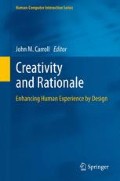Abstract
One of the questions posed at the National Science Foundation (NSF)-sponsored workshop on Creativity and Rationale in Software Design was on the role of rationale in supporting idea generation in the classroom. College students often struggle with problems where more than one possible solution exists. Part of the difficulty lies in the need for students to progress through different levels of development cognitively and intellectually before they can tackle creative problem solving. Argumentation-based rationale provides a natural mechanism for representing problems, candidate solutions, criteria, and arguments relating those criteria to the candidate solutions. Explicitly expressing rationale for their work encourages students to reflect on why they made their choices, and to actively consider multiple alternatives. We report on an experiment performed during a Data Structures course where students captured rationale.
This work was supported by NSF CAREER Award CCF-0844638 (Burge). Any opinions, findings, and conclusions or recommendations expressed in this material are those of the author(s) and do not necessarily reflect the views of the National Science Foundation (NSF).
We would like to thank the students taking the Data Structures course for their willingness to participate in this experiment, and fellow participants in the workshop on Creativity and Rationale in Software Design.
Access this chapter
Tax calculation will be finalised at checkout
Purchases are for personal use only
References
Amabile, T. M. (1983). The social psychology of creativity: A componential conceptualization. Journal of Personality and Social Psychology, 45, 357–377.
Atman, C. J., Cardella, M. E., Turns, J., & Adams, R. S. (2005). Comparing freshmen and senior engineering design processes: An in-depth follow-up study. Design Studies, 26, 325–357.
Baxter Magolda, M. B. (1992). Knowing and reasoning in college: Gender-related patterns in students’ intellectual development. San Francisco: Jossey-Bass.
Bloom, B. S. (Ed.). (1956). Taxonomy of educational objectives: The classification of educational goals. New York: David McKay Company, Inc.
Bruegge, B., & Dutoit, A. H. (2004). Object-oriented software engineering: Using UML, patterns, and Java (2nd ed.). Upper Saddle River: Prentice Hall.
Burge, J. E., & Brown, D. C. (2004). An integrated approach for software design checking using rationale. In J. Gero (Ed.), Design computing and cognition ’04 (pp. 557–576). Cambridge, MA: Kluwer Academic.
Carey, T., McKerlie, D., & Wilson, J. (1996). HCI design rationales as a learning resource. In T. Moran & J. M. Carroll (Eds.), Design rationale: Concepts, techniques, and use (pp. 373–392). Mahwah: Lawrence Erlbaum Associates.
Carroll, J. M. (2009, June) The essential tension of creativity and rationale in software design. Manifesto from the workshop on Creativity and Rationale in Software Design, State College, PA, USA.
Casaday, G. (1996). Rationale in practice: Templates for capturing and applying design experience. In T. Moran & J. M. Carroll (Eds.), Design rationale: Concepts, techniques, and use (pp. 351–372). Mahwah: Lawrence Erlbaum Associates.
Daughtry, J., Burge, J., Carroll, J. M., & Potts, C. (2009). Creativity and rationale in software design. SIGSOFT Software Engineering Notes, 34(1), 27–29.
Dewey, J. (1933). How we think. New York: D.C. Heath and Company.
Dym, C. L., Agogino, A. M., Eris, O., Frey, D. D., & Liefer, L. J. (2005). Engineering design thinking, teaching, and learning. Journal of Engineering Education, 94, 103–120.
Fischer, G., Lemke, A. C., McCall, R., & Morch, A. I. (1991). Making argumentation serve design. Human–Computer Interaction, 6, 393–419.
Fox, C. (2006). Introduction to software engineering design. Boston: Addison-Wesley.
Gamma, E., Helm, R., Johnson, R., & Vlissides, J. (1995). Design patterns: Elements of reusable object-oriented software. Reading: Addison-Wesley.
Glass, R. S. (1995). Software creativity. Englewood Cliffs: Prentice Hall.
Hamilton, H. R. (1974). Screening business development opportunities. Business Horizons, 7(4), 13–24.
King, P. M., & Kitchener, K. (1994). Developing reflective judgment: Understanding and promoting growth and critical thinking. San Francisco: Jossey-Bass Publishers.
King, P. M., & Kitchener, K. (2002). The reflective judgment model: Twenty years of research on epistemic cognition. In B. K. Hofer & P. R. Pintrich (Eds.), Personal epistemology: The psychology of beliefs about knowledge and knowing (pp. 37–61). Mahwah: Lawrence Erlbaum.
Kloss, R. J. (1994). A nudge is best: Helping students through the Perry scheme of intellectual development. College Teaching, 42, 151–158.
MacLean, A., Young, R. M., Bellotti, V. M., & Moran, T. P. (1991). Questions, options, and criteria: Elements of design space analysis. Human-Computer Interaction, 6, 201–250.
Moran, T. P., & Carroll, J. M. (Eds.). (1996). Design rationale: Concepts, techniques, and use. Mahwah: Lawrence Erlbaum Associates.
Perry, W. G. (1970). Forms of intellectual and ethical development in the college years: A scheme. New York: Holt, Rinehart, and Winston.
Pugh, S. (1991). Total design. Wokingham: Addison-Wesley Publishing Company.
Rice, J. A. (1995). Mathematical statistics and data analysis (2nd ed.). Belmont: Duxbury Press.
Schön, D. A. (1983). The reflective practitioner. New York: Basic Books, Inc.
Shah, J. J., Smith, S. M., & Vargas-Hernandez, N. (2003). Metrics for measuring ideation effectiveness. Design Studies, 24, 111–134.
van Aalst, J. W., van der Mast, C. A. P. G., & Carey, T. T. (1995). An interactive multimedia tutorial for user interface design. Computers and Education, 25, 227–233.
VanGundy, A. B. (1981). Techniques of structured problem solving. New York: Van Nostrand Reinhold Company.
Whiting, C. S. (1958). Creative thinking. New York: Reinhold.
Author information
Authors and Affiliations
Corresponding author
Editor information
Editors and Affiliations
Rights and permissions
Copyright information
© 2013 Springer-Verlag London
About this chapter
Cite this chapter
Burge, J.E., Brinkman, B. (2013). Using Rationale to Assist Student Cognitive and Intellectual Development. In: Carroll, J. (eds) Creativity and Rationale. Human–Computer Interaction Series, vol 20. Springer, London. https://doi.org/10.1007/978-1-4471-4111-2_9
Download citation
DOI: https://doi.org/10.1007/978-1-4471-4111-2_9
Published:
Publisher Name: Springer, London
Print ISBN: 978-1-4471-4110-5
Online ISBN: 978-1-4471-4111-2
eBook Packages: Computer ScienceComputer Science (R0)

